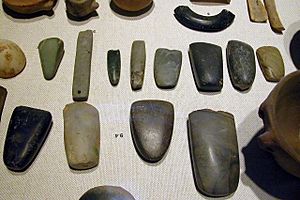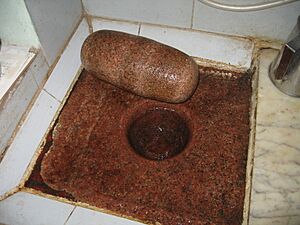Ground stone facts for kids
In archaeology, a ground stone is a special type of stone tool. People made these tools by grinding a rough piece of stone until it was smooth. This grinding could be done on purpose, or it could happen by accident as the tool was used.
Ground stone tools are often made from strong rocks like basalt, rhyolite, or granite. These rocks have a rough texture that makes them perfect for grinding other things. They were used to process many different materials, like plants for food or even other stones. You can find ground stone tools all over the world. Sometimes, they are the only ancient objects left at a dig site!
Contents
When Did Ground Stones Appear?
The idea of making tools by grinding stone is closely linked to the Neolithic period. This time is also known as the New Stone Age. The term "Stone Age" comes from a system created by a person named Christian Jürgensen Thomsen.
In some places, like the Middle East (Levant), ground stones showed up even earlier. They appeared during the Mesolithic period, which was before the New Stone Age. Interestingly, in ancient Japan, ground stone tools were used during the Japanese Paleolithic period. This might have been as much as 25,000 years before they became common in the Neolithic elsewhere!
How Were Ground Stones Made?
People made and used ground stones for many different reasons. The way a ground stone was made depended on what it would be used for. For example, making an axe head was different from making a fancy decoration for a home. However, some basic steps were common for most ground stone making.
Choosing the Right Stone
When picking a stone for a tool, its toughness was super important. If the stone wasn't strong enough, it would just break or crack easily. Then, all the hard work to make the tool would be wasted. The best stones wouldn't chip or crack when hit hard. Rocks like limestone, sandstone, granite, basalt, and rhyolite were good choices.
Some rocks called cryptocrystalline rocks were also great for ground stones. They have a very fine grain structure. This is helpful because the smaller the grains in a rock, the harder the rock usually is.
Drilling Holes in Stone
People could even drill holes in stones! They used sharp, pointed stones or hardened sticks. By spinning the sharp point with their hands and pressing hard, they could slowly drill a hole. Sand was often added to the hole to help speed up the process. The sand would act like a rough sandpaper, grinding away more of the stone. To make a hole all the way through, they would drill halfway from one side, then finish from the other.
Grinding and Shaping Tools
Some ground stone tools were made by accident, just from being used. For example, manos are hand stones used with metates (large grinding slabs). The surfaces of these tools became smooth and ground just from being rubbed together over and over.
Other tools, like adzes, celts, and axes, were made on purpose. This took a lot of time and effort! People would rub the stone against a harder stone or use sand. They often used water to make the grinding easier. These tools were usually made from strong, fine-grained materials. In the Arctic, people like the Norton and Thule cultures used ground slate tools. They made things like spear points and ulus (a type of knife). They would first shape the slate by chipping it or sawing it. Then, they would finish it by grinding it smooth with other stones.
What Were Ground Stones Used For?
Ground stones had many important uses in daily life.
Making Axe Heads
When making an axe head, the stone was shaped so it could be attached to a handle. This is called "hafting." To do this, the stone might have two grooves ground into one side. These grooves would hold the handle material, like wood or bone. This made sure the stone wouldn't move when the axe was swung. Strong animal hide would then be wrapped around the handle and into the grooves, tying the stone and handle together tightly.
Everyday Items and Jewelry
Ground stones were also used to make things for the home. People would spend a long time shaping large stones into bowls and pots for food.
Smaller, more detailed ground stones were used for jewelry. Things like beads and ear spools were a sign of high status. This was because it took so much time and skill to make such small and fancy pieces.
Grinding Food and Medicine
One very common use was for mashing seeds and leaves into powders. For this, people used rounded, smooth ground stones inside a stone bowl. This pair of tools is called a mortar and pestle. The material would go into the bowl (mortar). Then, the pestle would be moved and pressed into the mortar to grind the material into a fine powder. This process was used for making medicine and preparing food. Even today, mortars and pestles are still used in many kitchens!
The Life of a Ground Stone
Once a stone was shaped into a tool, it would be used to process many different things. Some tools were "active," meaning they did the action, like a handstone. Others were "passive," meaning they received the action, like a grinding slab.
At the end of its useful life, a ground stone could be reused. It might become another ground stone tool, or it could be used as a building stone. If it couldn't be used anymore, it was simply thrown away.
Studying Ground Stones in Archaeology
Archaeologists study ground stones to learn about how people lived in the past. They can tell us about farming methods and how plants were first grown by humans. For a long time, people thought ground stones were mostly used for processing grains. But now, studies show they were used for many different things!
To understand ground stones better, archaeologists use several methods. They look at the types of tools, study how modern people use similar tools, and even make copies of ancient tools to experiment with.
Looking for Plant Remains
Two important things archaeologists look for are starch grains and phytoliths. These are tiny plant parts that can get stuck in the small cracks of a ground stone. They are very well preserved in ancient sites. By finding and studying these plant remains, scientists can figure out exactly what the stones were used for.
To do this, they follow a special process. First, they carefully remove the tiny plant parts from the stone using a toothbrush and a special cleaning machine. Then, they look at these tiny remains under a powerful microscope. Finally, they compare the ancient starch grains to modern ones to identify the plants.
See also
- Stone tool
- Lithic reduction
- Microlith
- Household Stone tools in Karnataka




